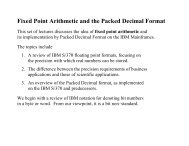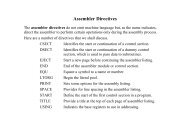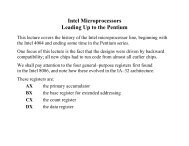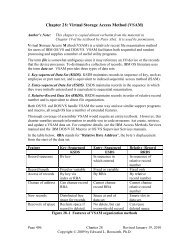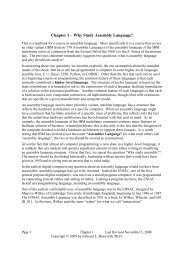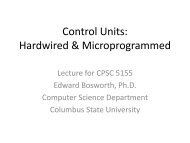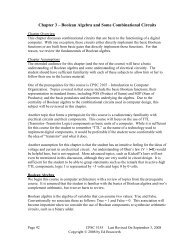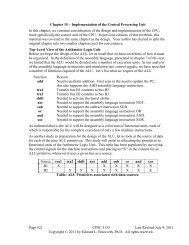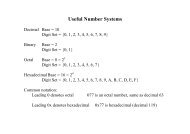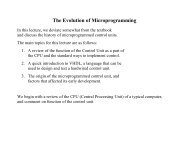PDF Version - Edwardbosworth.com
PDF Version - Edwardbosworth.com
PDF Version - Edwardbosworth.com
You also want an ePaper? Increase the reach of your titles
YUMPU automatically turns print PDFs into web optimized ePapers that Google loves.
S/370 Assembler Language Binary Integer Data<br />
Loading Addresses<br />
Up to now, we have discussed “value loaders”, such as the following example.<br />
L R3,FW1<br />
This finds the full–word at address FW1 and loads its value into register R3.<br />
At times, we shall need not the value stored at an address but the address itself.<br />
One possibility would be to store a return address to be used by a subroutine.<br />
There are two <strong>com</strong>mon ways to access the address and store it into a register.<br />
1. Use the L (Load full–word) instruction and use an address literal<br />
2. Use the LA (Load Address) instruction and use the label.<br />
The following two statements are equivalent. Each loadsR1 with the addressFW1.<br />
L R1,=A(FW1)<br />
LA R1,FW1<br />
In the System/360 and System/370 the address is treated as a 24–bit unsigned integer,<br />
which can be represented by six hexadecimal digits.<br />
If the address of FW1 isX‘112233’, register R1 getsX‘00112233’.<br />
LA (Load Address)<br />
The instruction is a type RX, with formatLA R1,D2(X2,B2). The opcode isX‘41’.<br />
The object code format is as follows.<br />
Type Bytes Operands 1 2 3 4<br />
RX 4 R1,D2(X2,B2) X‘41’ R 1 X 2 B 2 D 2 D 2 D 2<br />
Here is a template for the instruction: LA Reg,Address<br />
The first operand specifies any general–purpose register. This is indicated in the<br />
object code by the first hexadecimal digit in the second byte.<br />
The second operand references a storage address in the formD2(X2,B2). The index<br />
register is specified by the second hexadecimal digit in the second byte. Bytes 3 and 4<br />
together contain an address in base/displacement form, to which the index value is added.<br />
Consider the following fragment of code, which indicates one use of the instruction.<br />
A10<br />
LA R9,A10<br />
DC F‘100’<br />
Suppose that label A10 is subject to base register 3 containing valueX‘9800’<br />
with a displacement ofX‘260’. The object code for the LA instruction is as follows.<br />
41 90 32 60<br />
The code for theLA instruction isX‘41’. The second byte“90” is of the form R1X2,<br />
where R1 is the target register and X2 is the index register. As is standard, a value of 0<br />
indicates that indexing is not used in this address; it is pure base/displacement form.<br />
The LA instruction causes register R9 to be get valueX‘9800’ + X‘260’ = X‘9A60’.<br />
Page 230 Chapter 12 Last Revised July 6, 2009<br />
Copyright © 2009 by Edward L. Bosworth, Ph.D.



